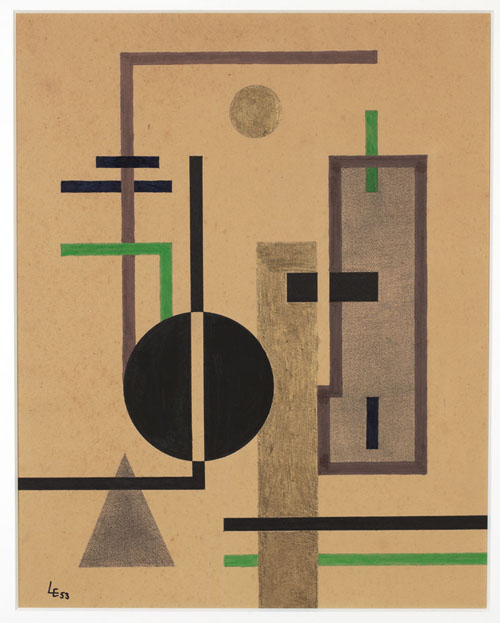Lajos d’Ébneth
Abstrakte Komposition, 1953
[Abstract Composition]
Tempera and pencil on cardboard
60 x 50 cm
© Artist
Photo: Gerhard Sauer
The work Abstrakte Komposition [Abstract Composition] from 1953 reveals Lajos d’Ébneth’s artistic roots in Constructivism. After studying engineering and art in Budapest, the Hungarian artist continued his studies in 1922 in Munich under the painter Franz von Stuck. His move to Berlin in April 1923, and his encounter with the lively art scene around László Moholy-Nagy and Herwarth Walden’s Der Sturm gallery prompted d’Ébneth to destroy his previous work, with its strong symbolist and expressionist influences. He now ventured in a new direction aligned solely to modern, abstract constructive developments. And he moved with self-assurance in avant-garde circles, among Dadaists, Constructivists and De Stijl-artists. In particular he benefited from his contact with Kurt Schwitters, who took the young artist under his wing. D’Ébneth invited Schwitters to the house he took in December 1923 in Kijkduin, Holland, and the two spent the summer of 1926 there exchanging artistic ideas.
In the latter half of the 1920s, Lajos d’Ébneth reached the zenith of his creative production. Full of enthusiasm, he applied the modernist grammar of forms to various fields: the result was paintings, reliefs, collages, typographical designs, adverts, a theatre of mechanical figures, and ultimately also architectural designs. He participated in exhibitions at the Sturm gallery, and in 1926 became co-editor of the art journal Het Woord. In 1927 he published his graphic designs in the magazine i10, became a member of the Berlin group Die Abstrakten, and was invited by Walter Gropius to a working sojourn at the Bauhaus in Dessau. However, d’Ébneth’s successful career in the arts underwent a sudden break in the early 1930s. In 1933, his then wife Nelly wrote to the Berlin artist Hannah Höch that he was “no longer a painter” and had “neither money nor prospects”.
In 1949 d’Ébneth settled in Peru, where in some respects he picked up on his previous work. The drawing in the Marli Hoppe-Ritter Collection originates from this second phase. It shows the basic geometrical forms of the rectangle, circle and triangle, all brought into harmonious interplay by a tracery of orthogonals. Apart from a free-floating, golden circular shape, the elements are all mutually connected in such a way that they nudge or overlap one another. D’Ébneth’s composition shows in exemplary form how Modernist artists strived to create a pictorial space solely from shapes and colours quite independent of perceived reality. (Susann Scholl)
Lajos d’Ébneth
1902 born in Szilágysomlyó (today: RO)
1982 died in Chaclacayo, Lima


